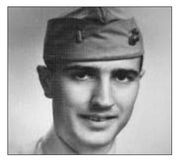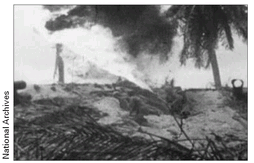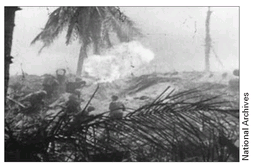War Stories II (44 page)
Authors: Oliver L. North

To the Marines headed toward the beach and the pilots flying overhead, it looked as if the entire island was on fire. The wooden barracks, equipment sheds, and Shibasaki's headquarters building were blasted into splinters and burning. Huge billows of black smoke and suspended particles of sand were blasted into the air by the shells and bombs, and the cloud drifted a mile into the sky.
Unfortunately, the first three assault wavesâusing 125 LVTsâtook much longer than expected to make it across the coral reef. As soon as the destroyers stopped firing, the Japanese defenders rushed back to their guns, raking the tracked amphibians as they crawled up onto and across the reef
where the water was only two or three feet deep. Few of them made it to the beach unscathed. Worse still, all the LCMs and LCVPs carrying the fourth, fifth, and sixth waves for Red Beaches One and Two ground to a halt 600 to 1,000 yards offshore, forcing the Marines to disembark and wade through chest-high water under heavy machine gun and mortar fire. In many places, the water was even deeper. At Red Beach Three, those who made it to the beach were exposed to withering fire from Japanese gunners hidden in the pilings of the long pier jutting out into the lagoon.
where the water was only two or three feet deep. Few of them made it to the beach unscathed. Worse still, all the LCMs and LCVPs carrying the fourth, fifth, and sixth waves for Red Beaches One and Two ground to a halt 600 to 1,000 yards offshore, forcing the Marines to disembark and wade through chest-high water under heavy machine gun and mortar fire. In many places, the water was even deeper. At Red Beach Three, those who made it to the beach were exposed to withering fire from Japanese gunners hidden in the pilings of the long pier jutting out into the lagoon.
For the Marines who had watched the pre-landing bombardment and finally made it to the beach, the results of that volume of enemy fire was unbelievable. It seemed like the only thing those thousands of tons of munitions had done was to push a little sand around and cut down a few palm trees.
Twelve miles offshore, General Smith and Rear Admiral Hill waited for a situation report aboard the flagship USS
Maryland
. But most of the radios that the assault waves had taken with them had been soaked during the reef crossing and were now useless. It was only after Colonel David M. Shoup, the assault commander, managed to get up to the seawall and find a dry radio did they realize the magnitude of the carnage on the beach. Smith immediately committed the division's reserves to the fight, sending in another 1,100 Marines. By 1800, nearly 5,200 exhausted troops were ashoreâmost of them in two widely separated pocketsâand almost a third of them casualties. One of those who had made it was Lieutenant Don Lillibridge from Mitchell, South Dakota.
Maryland
. But most of the radios that the assault waves had taken with them had been soaked during the reef crossing and were now useless. It was only after Colonel David M. Shoup, the assault commander, managed to get up to the seawall and find a dry radio did they realize the magnitude of the carnage on the beach. Smith immediately committed the division's reserves to the fight, sending in another 1,100 Marines. By 1800, nearly 5,200 exhausted troops were ashoreâmost of them in two widely separated pocketsâand almost a third of them casualties. One of those who had made it was Lieutenant Don Lillibridge from Mitchell, South Dakota.

SECOND LIEUTENANT
DON LILLIBRIDGE, USMC
Betio Island, Tarawa Atoll
20 November 1943
2300 Hours Local
DON LILLIBRIDGE, USMC
Betio Island, Tarawa Atoll
20 November 1943
2300 Hours Local

I was a lieutenant in A Company, 1st Battalion, 2nd Marines. I was the youngest officer in the battalion, just turned twenty-two, but I had thirty-nine
men in my rifle platoon who were seventeen, eighteen, and nineteen years old, so they were a lot younger. I'd never been away from home in my life and I was very inexperienced.
men in my rifle platoon who were seventeen, eighteen, and nineteen years old, so they were a lot younger. I'd never been away from home in my life and I was very inexperienced.
We loaded up, and after we were on board, we were told where we were going. Nobody had ever heard of Tarawa or knew where it was. I saw the stuff on the map and it was just little dots in the middle of the Pacific Ocean. A captain assigned all of us replacement officers to different units.
Tarawa was my first battle. In the dark you could see the naval shells streaking red through the sky onto the island. And following all the explosions after the aerial and naval bombardment of the island, we assumed that there would probably be nothing left. It just didn't seem possible that there could be anybody left alive on the place.
When we hit the reef and started to go up over it, we were hit by machine gun fire. I remember a bullet came through the Amtrac because it wasn't armored. It passed between my dungarees and my backpack. I could feel the heat as it went through. And I thought,
Maybe I've been hit!
But it was a fraction offâif it hadn't been, it would've shattered my spineâso I was lucky.
Maybe I've been hit!
But it was a fraction offâif it hadn't been, it would've shattered my spineâso I was lucky.
Â
Marines at Tarawa

We hit the beach and all leaped out. I jumped out first, by the seawall, and on the very narrow beach were bodies everywhereâin the water, floating on the water, and on the little beach. My guys were jammed up against the seawall for protection against enemy fire.
I leaped up over the seawall and I just took off inland. And they all came after me. But the Marines who followed us, about two or three minutes later, all got shot, just wiped out. I ran inland until I came to this large, twenty-by-twenty-foot depression in the sand, about two or three feet deep. And there were guys in there, and facing me with his back to the wall was Lieutenant Seeley.
He looked at me and said, “Lilly . . . I faced death eleven times today.” One of the curious things about Tarawa was, you almost never saw the enemy. They were in the bunkers, and they were firing at you and you were firing at them. The only way to get them outâas it turned outâwas when a handful of Sherman tanks got ashore.
There was this big structure built with coconut palms and concrete. It must've been thick because it was very solid. It hadn't been destroyed by the naval bombardment and I saw it had a huge aperture about a foot high and about four feet long. This tank came up and I pointed to it. He rolled right up to it, stuck the muzzle right up into the opening, and fired a couple rounds. That's the kind of thing, plus the flame-throwers that the combat engineers, the flame-thrower demolition outfit, used on the bunkers. The flame-throwers didn't just burn people; they also sucked all the oxygen out of these structures, and the people inside suffocated.
Â
Marines using a flame-thrower on Betio.

Since many of the Japanese were killed in their bunkers, most of the bodies all over the island by the end of the battle were Marines. So many were killed just trying to get on the beach. And that held true for the second day as well.
That experience was a devastating shock. It was the single most traumatic event I've ever experienced in my life. I lost twenty-six of the thirty-nine men in my platoon. By the third night, I was the only officer left in the company, which was about the size of my original platoon
Tarawa was so small that you could stand on one side and see over to the other side, from the lagoon to the ocean. It was 800 yards wide at the widest point, and then tapered down to about four feet at the east end. It was about two and a half miles long. That's what made the battle so unusualâits tiny size and all this concentrated fury.
I didn't get across the island until the morning of the third day. Bodies were everywhere: a hand here, an arm there, a leg, a shattered torso. A head, even.
Well, even though I had another battle ahead of me, Tarawa was the first one, and it's the impact of losing so many guys that I think really lasted throughout my whole life. None of this occurs at the time of the battle, you understand. This effect and the impact of it all comes after the battle is over.
 HQ 2ND MARINE DIVISION
HQ 2ND MARINE DIVISIONUSS MARYLAND
5 MILES WEST OF BETIO ISLAND, TARAWA ATOLL
20 NOVEMBER 1943
1830 HOURS LOCAL
5 MILES WEST OF BETIO ISLAND, TARAWA ATOLL
20 NOVEMBER 1943
1830 HOURS LOCAL
With four battalions of his 2nd Division ashore, General Julian Smith and his staff sought ways to break the bloody deadlock. Once darkness fell, the shooting stopped almost entirely. An expected Japanese counter-attack never materialized because the communications wires connecting Admiral Shibasaki with his subordinate commanders had all been cut by the furious bombardment and the gunfights earlier in the day.
Exhausted Marines from intermingled units held onto their positions in three-to-five-man foxholes dug in the soft sand or in shell holes and bomb craters created by the pre-landing bombardment. On the beach, Navy medical corpsmen continued to load wounded into LVTs, shuttling them back out to the ships. On their return trips to the beach the Amtracs brought in 75 mm howitzers, mortars, ammunition, fresh working radios, and water for the terribly dehydrated Marines.
As the night wore on, LCVPs and LCMs that had made it across the reef at high tide were policing up bodies and equipment floating in the lagoon. Among the salvage officers engaged in this grisly task was movie star Eddie Albert. Now a lieutenant (jg), he had volunteered for the Navy after Pearl Harbor and was serving as a small boat officer on the USS
Sheridan
, a transport anchored offshore.
Sheridan
, a transport anchored offshore.
At thirty-three, Albert was likely one of the oldest lieutenants in the Navy. He could have been in Hollywood making training movies. Instead, he went to Officers' Candidate School, got his commission, and was assigned as a salvage officer off Betio.
During the operation he made twenty-six trips bringing back the wounded from Betio. On one of his forays into the seawall, he picked up a wounded Japanese officer. He told how it happened: “There were piles of dead and wounded and I was in the mess . . . and a Japanese was among the wounded . . . standing up. And I thought, âWell, he's the only Japanese that knows what is going on. Maybe I could get him up to our ship.' He's the only Japanese that the interrogators had to talk toâthe rest of them were dead.”
Eddie Albert said that the multiple trips to the beach were just part of “doing his job.” But he was awarded the Bronze Star for valor. One of those who believe he deserved it is Dean Ladd, a rifle platoon commander who spent much of the night of 20 November circling offshore in the lagoon, waiting to get ashore and help his pinned-down comrades. Ladd was only twenty-two but already a combat veteran of Guadalcanal by the time he reached Tarawa.
Other books
Summer on the Moon by Adrian Fogelin
El legado del valle by Jordi Badia & Luisjo Gómez
The Burden of the Protector by Eston, S.C.
Odd Billy Todd by N.C. Reed
Born to be Broken (Alpha's Claim Book 2) by Addison Cain
Flight of the Sparrow by Amy Belding Brown
Killer Dreams by Iris Johansen
The Club Sin Series 4-Book Bundle by Stacey Kennedy
The Universe Within by Neil Shubin
Among the Shrouded by Amalie Jahn
